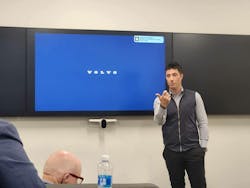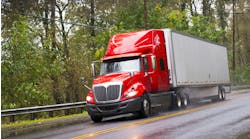GREENSBORO, North Carolina—Autonomous trucking means more than just a truck that can drive itself. It means a network of dedicated, coordinated infrastructure to make self-driving trucks a viable solution for meeting freight demand.
That is what Sasko Cuklev, head of on-road solutions for Volvo Autonomous Solutions, presented to media here.
“It is not as simple as many thought in the beginning; ‘Just give me your truck, we will upfit it, and then it will drive.’ There is something else that is required,” Cuklev said.
See also: How autonomous trucking is already transforming logistics
A new form of transportation
Autonomous trucking will not be so simple as augmenting carriers’ typical operations with an autonomous driving system.
“We should see this as a new way of transporting freight,” Cuklev said. Autonomous trucking could be a wholly separate form of transportation alongside rail, ship, and traditional trucking.
Autonomous trucks are not replacing traditional drivers any time soon, according to Volvo. While autonomous operations show great promise in increasing truck utilization, they also have unique needs compared to traditional trucking. To be as safe and efficient as possible, autonomous trucks would need catered equipment, infrastructure, and routes.
Still, as demand for freight movement increases, autonomous trucks have an opportunity to move goods with high efficiency. The National Transportation Research Group estimates that the weight of freight moved in the U.S. could increase 64% by 2050 and the Department of Transportation makes similar projections.
“All the predictions are showing that there will be increasing demand and we will need to have these types of solutions,” Cuklev said.
See also: Fleets Explained: Autonomous vehicles
Crossing the middle mile
Volvo’s plans to launch its first two autonomous U.S. truck routes in Texas: from Dallas to Houston and Fort Worth to El Paso.
The routes provide Volvo a suitable environment to build out autonomous vehicle infrastructure and showcase the trucks’ operations. However, these routes don't meet the best use case for modern autonomous trucking.
“It’s not optimal from a business value perspective; I would say it’s almost too short,” Cuklev said. “When you get the longer stretches, that’s where you can get value out of autonomy.”
Autonomous truck developers are instead looking at the middle mile as an ideal application for AVs. Cuklev called long-haul, hub-to-hub operations “the holy grail of autonomous.”
First- and last-mile operations can be complicated and challenging for AVs. Routine operations in a highway haul, on the other hand, are where autonomous systems can shine.
“We will move the complexity that the first and the last stretch gives, so that we can focus on running autonomously between A and B,” Cuklev said.
Cuklev, like other autonomous truck leaders, envisions a world where humans would drive a load manually from the customer depot to a transfer hub next to the highway. From there, an AV would haul the load to a transfer hub nearest to its destination.
Autonomous implementation could also improve drivers’ home time and reduce hours-of-service limitations.
“We know that the long stretches, being out for days or weeks, is not ideal for a driver,” Cuklev said. With autonomous operations, “the drivers can go for the shorter hauls, where they can come back to be with their families.”
Unique needs for autonomous trucking
Autonomous trucks need more than just a sophisticated autonomous driving system. To meet their potential as efficiently and safely as possible, AVs need a suite of dedicated infrastructure assets.
Cuklev said that autonomous operations will need their own terminals, operations, transportation and fleet management, and uptime services. Such infrastructure could grant autonomous leaders like Volvo the ability to monitor and steer the entire solution.
“We will know the ETA; we will know where it is,” Cuklev said. “We will know if something is not right, if we will have to kick in a back-up solution, if roadside assistance will have to come in, and so on.”
An integrated network of these assets could lead to a seamless flow of information across all parties—from the truck and its autonomous driver to dedicated hubs for coordinated freight management, nearby dealers for quick service and uptime, and customers for trust and transparency.
“The other pieces are super important to have in place. Otherwise, this will not be a feasible solution,” Cuklev said. “If we only give this [truck] to a customer, they will not be able to do much with it.”





